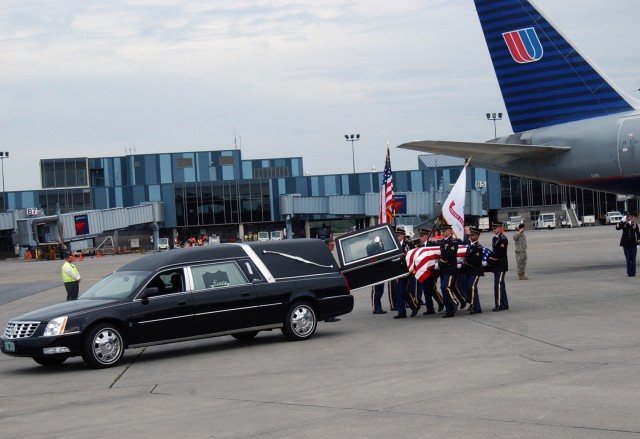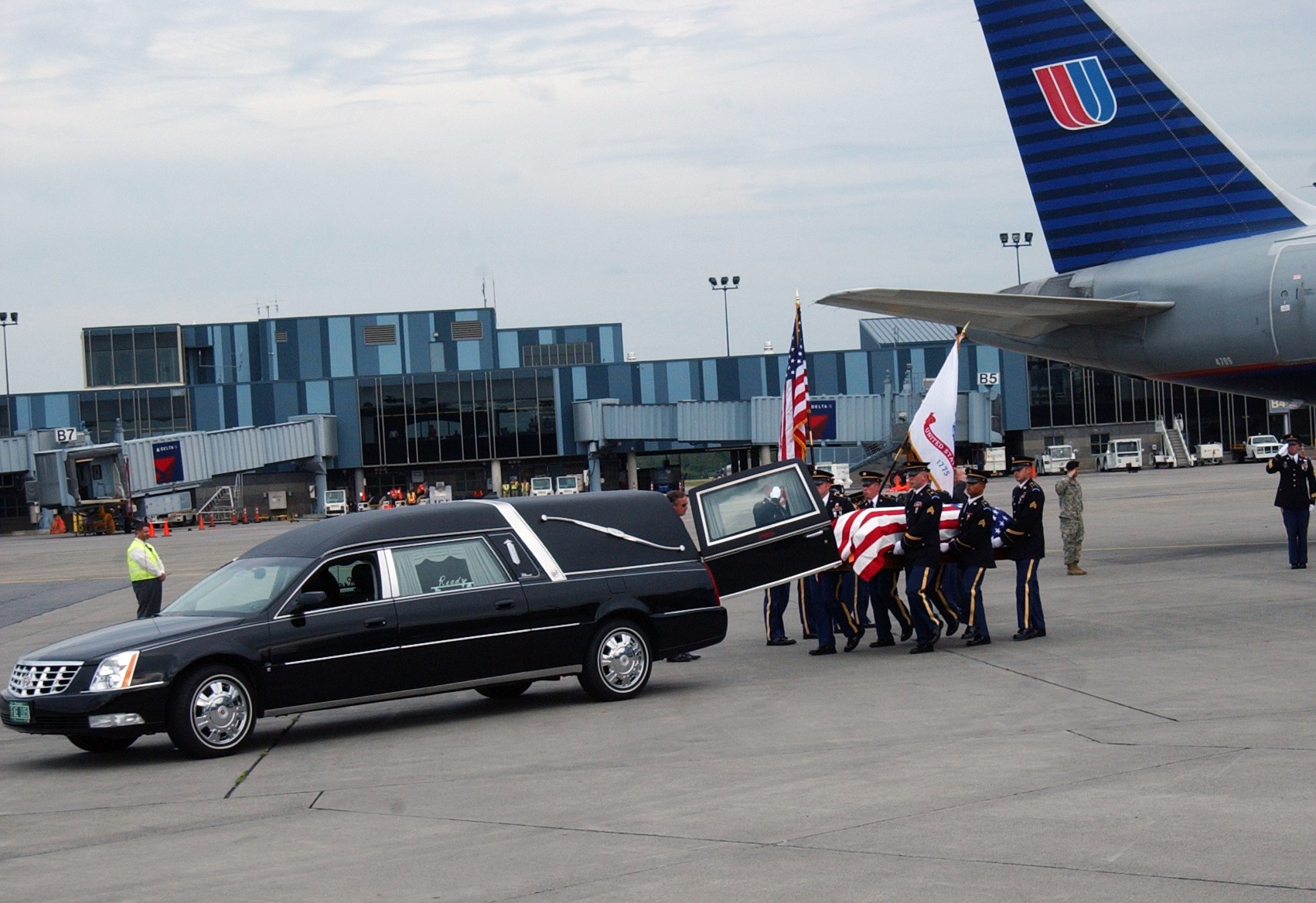
LATHAM, N.Y. (Aug. 20, 2010) -- When U.S. Army Air Forces pilot 1st Lt. Ray Fletcher returned home to Essex Center Vermont from World War II, on Aug. 17, 2010, the New York Army National Guard was there to help him along.
Eight members of the New York Military Forces Honor Guard conducted an honorable transfer of remains ceremony at the Albany International Airport, moving what was left of Ray Fletcher from a United Airlines jet to the hearse waiting to carry the casket back to his native state.
"It doesn't really matter when our servicemembers have fallen. We still recognize the sacrifice they made and it's nice to be here for this," said Lt. Col. Richard Sloma, who acted as casualty assistance officer for the event.
"For those of us who are in the service, we understand very quickly that we're all family, regardless of branch of service, regardless of when it happened we still pay that tribute, " Sloma said.
Fletcher died on May 10, 1944, when the B-25 bomber he was piloting crashed into a mountain side on the Mediterranean island of Corsica. His plane, which was assigned to the 57th Bombardment Wing was on a routine courier mission when it crashed, killing four people, including a female Red Cross volunteer, due to bad weather.
Although human remains had been recovered in 1995 and 2005, they were not positively identified, after DNA comparison with surviving family members until 2009.
Fletcher's sole surviving relative, Rhette Fletcher, a cousin, opted to have him buried at Mountain View Cemetery in the hometown he left more than 66 years ago. Funeral services were set for August 20 in St. James Episcopal Church, Essex Center, Vt.
Members of the New York Honor Guard, which participated at more than 10,000 funerals in 2009, normally render honors for veterans who have died in the current wars in Iraq or Afghanistan. But they stand ready to honor the dead of all our conflicts, said Staff Sgt. Wayne Stone.
"It's a sense of pride," said Stone, the noncommissioned officer in charge for the New York State Military Forces Honor Guard. "It feels good ... that we're actually giving peace to him today."
In April 2009, for example, members of the New York Military Forces Honor Guard provided funeral honors for Sgt. Dougal Espey, a native of Elmira, N.Y., who died during the Korean War in 1950 but whose remains were not identified until 2009.
Carolyn Chapin, a Red Cross Volunteer also on board the flight, was laid to rest in Woodbury, Conn., in August of 2009.
Two other casualties from the crash were laid to rest in May to remember the 66th anniversary of the crash, Staff Sgt. Edwin Elliott in Mattoon, Ill., and Cpl. Richard Loring in Carver, Mass. Remains of the final casualty, Capt. Lewis Geerlings, were not recovered.
Back in May of 1944, the Army Air Force search team that finally reached the wreck 3,500 feet up the side of Mount Cagna, a week after the crash, found the aircraft almost totally destroyed.
In September of 1944, Army Graves Registration personnel reported making the difficult trek to the crash site and that remains there were non-recoverable due to the impact of the crash and fire that followed.
A similar board of review in February 1948 also concluded that the remains of Fletcher and accompanying personnel on board the aircraft to be officially declared not recoverable.
In the spring of 1989, 45 years after the crash, the Corsican Gendarmerie notified Army Memorial Affairs Activity in Europe that partial remains of crash victims had been recovered in 1988. A military investigation team visited the site in June 1989, concluding that no additional recovery work would be feasible at the site due to the hazardous and particularly difficult area for search and recovery.
The remains found by the Corsican Gendarmerie were turned over to the military's Central Identification Laboratory, Hawaii (CILHI) for analysis in 1995. At the time, these remains included no information correlating the wreckage or remains with a known incident or individuals. The accession was placed on hold in 1995, pending further evidence.
French nationals again discovered remnants at the site in 2003 and 2004, turning over the additional non-biological items to CILHI in May, 2005. A Joint POW/MIA Accounting Command (JPAC) Team from the Department of Defense investigated the site in September, 2005, recovering additional human remains and personal effects.
Once analysis placed Fletcher's remains with the crash site, CILHI and JPAG concluded in late 2009 that the remains recovered to be those of Fletcher and will be returned to his home state of Vermont as his final resting place.

Social Sharing